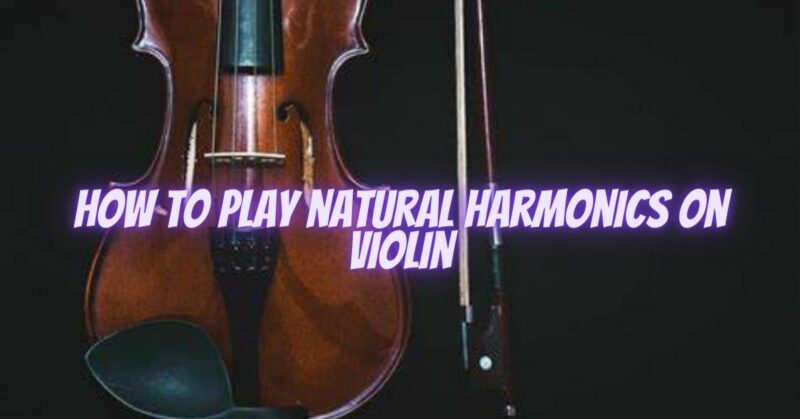Natural harmonics on the violin produce enchanting and ethereal sounds, adding depth and color to your playing. Playing natural harmonics requires precise finger placement and bowing technique. In this article, we will explore the step-by-step process of producing natural harmonics on the violin and provide practice tips to help you master this beautiful technique.
Understanding Natural Harmonics: Natural harmonics are produced by lightly touching the string at specific nodal points while bowing an open string. These nodal points divide the string into vibrating segments, creating pure, bell-like tones.
Step-by-Step Guide to Playing Natural Harmonics:
- Identify the Harmonic Node: Each open string on the violin has specific nodal points where natural harmonics occur. These nodal points are located at fractions of the string length, such as half, one-third, one-fourth, etc. Familiarize yourself with the nodal points on each open string.
- Lightly Touch the String: With the bowing hand, draw the bow across the open string while lightly touching the string with your left-hand finger at the desired nodal point. The touch should be gentle, barely making contact with the string.
- Finger Placement: For the first harmonic, place your left-hand finger directly over the nodal point, dividing the string into two equal segments. For other harmonics, adjust the finger placement according to the specific nodal point fractions.
- Bowing Technique: Maintain a controlled and consistent bowing motion. Start the bow stroke slightly closer to the bridge than when playing normally. Apply a lighter bow pressure than usual to allow the harmonics to ring clearly. Experiment with bow speed and contact point to find the sweet spot that produces the desired harmonic sound.
- Listening and Refinement: Listen carefully to the produced harmonics to ensure they sound clear and pure. Adjust your finger placement, bowing pressure, and bow speed as needed to refine the tone and enhance the resonance. Aim for a sustained, bell-like sound with a focused and consistent pitch.
Practice Tips for Mastering Natural Harmonics:
- Start with Simple Exercises: Begin by practicing simple exercises on each open string, focusing on producing clear and resonant harmonics. Gradually progress to more challenging exercises that involve shifting between different harmonics or playing harmonics in musical passages.
- Isolate Finger Placement: Practice finding and placing your left-hand finger accurately on the nodal points without using the bow. Focus on developing muscle memory and a keen sense of finger placement for each harmonic.
- Experiment with Bowing Techniques: Vary your bowing techniques, including bow speed, pressure, and contact point, to explore different tonal qualities and effects. Experiment with different bowing styles, such as legato, staccato, or tremolo, to expand your range of expressive possibilities with natural harmonics.
- Explore Different Nodal Points: Experiment with different nodal points on each string to discover the unique harmonics they produce. Practice playing harmonics at one-third, one-fourth, or other fractions of the string length to become comfortable with different harmonic positions.
- Integrate into Musical Repertoire: Incorporate natural harmonics into your repertoire, including solo pieces, orchestral excerpts, or chamber music. Practice integrating them seamlessly within musical phrases, paying attention to dynamics, expression, and the overall musical context.
- Record and Evaluate: Record yourself while practicing harmonics to assess the clarity, intonation, and resonance of your harmonics. Listen back to identify areas for improvement and make adjustments accordingly.
Conclusion: Mastering natural harmonics on the violin opens up a world of expressive possibilities. By understanding the nodal points, refining fingerplacement, perfecting bowing technique, and practicing with focus and intention, you can produce beautiful and resonant natural harmonics. Remember to start with simple exercises, gradually progress to more complex passages, and integrate harmonics into your musical repertoire. With patience, practice, and a keen ear for tone and intonation, you will be able to master the art of playing natural harmonics on the violin and add a touch of magic to your performances.

